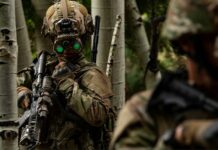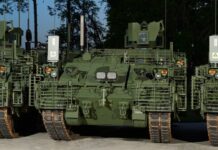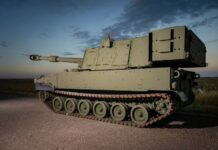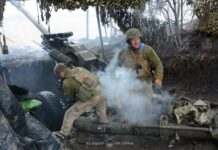The US Army has introduced a swarm of 40 Unmanned Aerial Vehicles (UAVs) into its opposition force scenarios at the National Training Center (NTC) in California, according to an 11 September 2022 tweet by Brigadier General Curtis Taylor, the NTC’s Commanding General.
Drones in the Exercise
The footage showed the drones advancing as the first part of an assault led by the 11th Armoured Cavalry Regiment (ACR) against the 1st Armoured Division. Each of the quadcopters was equipped with a camera, they were capable of carrying a lethal munition and, for the purpose of the exercise, were equipped with the Multiple Integrated Laser Engagement System (MILES), which is used to simulate kills and casualties.
The regiment has access to a total of 50 drones, each with a maximum flight time of 28 minutes and capable of carrying a 3.6 kg payload. They have been in use in the reconnaissance role since 2019, according to a February 2020 article published by High Desert Warrior, a civilian newspaper that is an authorised publication for the staff and families at Fort Irwin where the NTC is based. However, this is thought to be the first indication of how they are used as a swarm.
Potential Adversary
The 11th ACR is the NCT’s Professional Opposition Force (OPFOR), trained to mimic the capabilities of potential opponent’s such as the Russian or Chinese Armed Forces. The initiative is known as the Blackhorse Drone Training Programme, and it is designed to provide units visiting the NTC with live experience of drone tactics, techniques, and procedures (TTPs) that an enemy might use in combat.
“Drones will be as important in the first battle of the next war as artillery is today,” Brig Gen Taylor said in his tweet. The development is driven by the NTC’s mission to replicate emerging trends in the character of war.
Importance of Drone Swarms
It is clear from multiple conflicts; The Libyan Civil War, the wars against Daesh in Iraq and Syria, attacks launched by Yemen’s Houthis against Saudi Arabia, the war between Armenia and Azerbaijan, and of course Ukraine, that drones are a permanent fixture of modern conflicts. Their proliferation has mutated the character of war, with the result that tactical and operational surprise can be difficult to achieve. Consider, for example, the Russian attempt to cross the Siversky Donets River in May 2022, which was discovered through a combination of drones and on-the-ground reconnaissance leading to the loss of around a battalion of equipment.
Ample footage from the Armenian-Azeri conflict over Nagorno-Karabakh further emphasises that infantry formations and armour can be easily detected and that drone-based Intelligence, Surveillance and Reconnaissance (ISR) can provide persistent surveillance of a position unnoticed. Typically, these conflicts have included the integration of the ISR asset into a targeting cycle, combining artillery or loitering munitions with the strike capabilities of the drones themselves to cause heavy attrition.
However, other conflicts, such as the counter-insurgency campaign in Mali, or the Syrian civil war, show that swarms of small drones are regularly used to carry small munitions onto a target. In the case of the campaign to defeat Daesh in Mosul, they were used to coordinate company-level attacks and conduct mortar strikes against Iraqi command posts.
It follows that armed forces can therefore expect to face drones regardless of whether they are engaging a peer opponent such as Russia, or a mid-tier opponent with access and funds for military and even commercial drones, or a sub-peer, non-state opponent. In each scenario they might present a different level of risk.
UAV Dangers
In situations where the opponent is able to coordinate real-time ISR feeds with indirect fire assets, the results can be catastrophic, as both Russia and Ukraine have demonstrated. In others, the use of small drones can rapidly elevate the costs of a deployment. A noteworthy example is the damage inflicted to Russia’s Khmeimim airbase in Syria during 2018 by a swarm of drones armed with grenades.
Consequently, it is a necessity for forces to train against drones on a regular basis. The units that rotate through the NTC are given the hand-held DroneBuster gun, which jams the control signal of a drone, either bringing it to the ground, or returning it to its last known waypoint. However, counter-drone tactics and training can and should include the use of decoys and camouflage to reduce certainty in gathered ISR. Ultimately, the defending force needs to ensure that the drone fails in its mission of gathering ISR or completing an engagement, this means that the use of kinetic force is not always necessary, but the skills to minimise a drone’s success must be practised regularly and in scenarios that are as realistic as possible.
For many forces this represents a unique challenge. The US Army is fortunate in that it has access to very large areas of training real estate with relatively free reign over the airspace. For many European countries however, with a crowded airspace that must be deconflicted through civil aviation authorities ahead of any exercise, as well as restrictive training safety regulations, it may prove very challenging to integrate drones of any size into a combined arms training exercise, let alone practise the electronic warfare capabilities needed to jam a drone or degrade its sensor suite.












